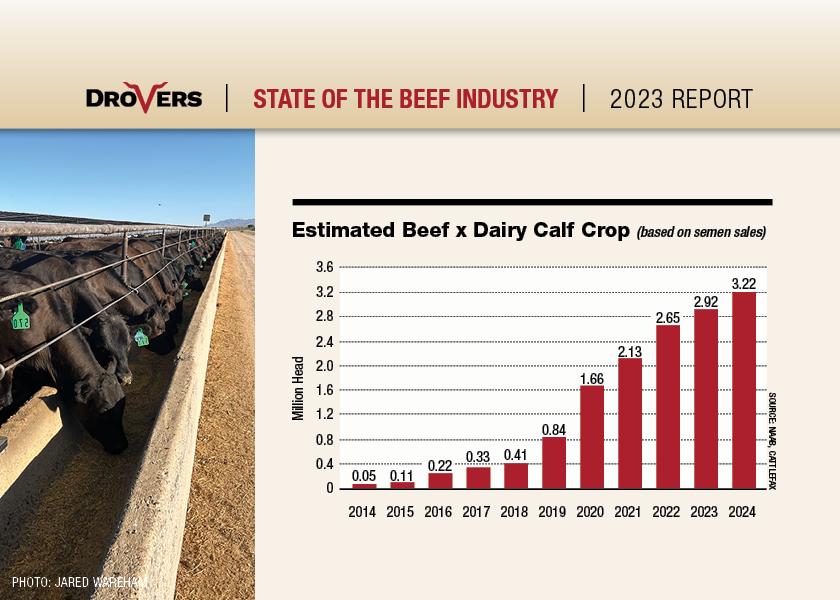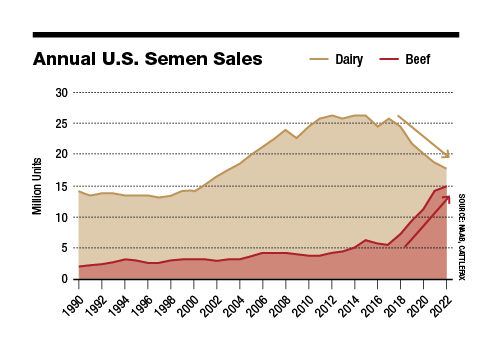Beef-on-Dairy: A Revolution in American Beef Production?

Editor's Note: This article is the fifth in a series that comprise Drovers 2023 State of the Beef Industry. The full report will appear as a 16-page special section in the September 2023 issue. Additional articles from the series will be published in this space in the following days.
Beef-on-dairy is arguably the most significant advancement for the U.S. beef industry in a generation, and no current review of the State of the Beef Industry would be complete without examining its impact.
Further, the recent growth of beef-on-dairy has been significant enough that it could alter the cyclical impact the beef industry is experiencing from drought-forced herd reductions. For instance, Patrick Linnell says CattleFax estimates the industry will produce 2.92 million beef-on-dairy calves this year and 3.22 million in 2024 (see chart). Some industry observers believe those estimates are conservative.
Regardless of the exact number, Dale Woerner, animal and food science professor at Texas Tech University, told Drovers, “The number will continue to grow as the beef cowherd shrinks.”
That’s due, primarily, to the growing acceptance of beef-on-dairy calves by both cattle feeders and beef packers, and the realities of empty pens and shackle space the industry faces over the next few years.
 Targeted Breeding
Targeted Breeding
“Right now, everybody needs cattle,” says Jared Wareham, North America NuEra business development manager at Genus ABS. “The beef-on-dairy crosses, especially the good ones, are in high demand.”
When the beef-on-dairy segment first began to develop a few years ago there was little attention given to the genetics of the beef semen used because it was assumed the result would produce a more valuable calf. That was true, but Wareham says that shotgun approach has given way to much more targeted breeding.
“We saw good crossbreds and bad ones, and nobody wants bad ones,” Wareham says of the early efforts to implement beef-on-dairy. “But the focus on creating the good ones continues to rise, and now we have enough feedlot performance and carcass data to make more of the good ones.”
But the rise in beef-on-dairy is also influenced by the modern dairy production system. Today’s dairy industry, with a relatively stable cowherd of 9.3 million to 9.4 million highly efficient cows, operates under an intense genetic selection system to identify the most productive dairy heifers. The development of sexed semen has become a common tool used to further those efforts and sexed semen allows dairy producers to produce optimal replacement heifers from their best dairy cows with the genetically inferior cows available for breeding to beef sires.
In other words, sexed semen helps reduce the number of dairy cows needed to produce dairy heifers, thus allowing more dairy cows available for breeding to beef sires. That advancement has led to a dramatic decrease in the use of dairy semen and a corresponding increase in the use of beef semen. In fact, the use of beef semen has nearly tripled since 2017.
Advancing Sustainability
At the outset, cattle feeders knew a beef-on-dairy cross would grow faster, be more tolerant of extreme weather conditions and produce a beefier carcass than traditional dairy calves, but that’s a low bar for today’s beef industry, and many feedlots and packers are adjusting their sights much higher.
“At first everybody saw beef-on-dairy as a way to create a dual-stream production system for milk and beef,” Wareham says. “In the beginning, breeding those dairy cows was just a stab in the dark. We used Angus genetics, but now we’re seeing a number of composite sires designed specifically for beef-on-dairy be quite successful.”
Packers and retailers also have a favorable view of the beef-on-dairy segment. For instance, a research project by Woerner and colleagues found strip loin steaks from beef-on-dairy cattle have improved color and shelf-life performance, as well as improved steak shape compared with traditional, straightbred dairy cattle. On average, the research found beef-on-dairy cattle produce carcasses with greater red meat yield than conventional Holstein steers, and high-yielding beef-on-dairy cattle can yield as high or higher than conventional beef cattle.
Woerner and his colleagues at Texas Tech have also collaborated with Cargill for over three years on the Dairy Beef Accelerator, a program to better understand the opportunities of beef-on-dairy. That research has documented several benefits for producers, packers, consumers and the environment. Some highlights:
- Compared to purebred dairy calves, beef-on-dairy calves can provide higher-quality beef products without impacting current milk production efficiencies.
- Beef-on-dairy calves show greater feed efficiency, which lowers the environmental footprint from their production.
- Increased feed efficiency significantly reduces greenhouse gas (GHG) emissions.
- The practice benefits meat quality. Beef-on-dairy delivers increased volumes of higher-grading beef carcasses, providing feedyard operators more access to value-based marketing opportunities.
“The beef and dairy industries can to work together to produce even more efficient beef animals,” Woerner says. “Crossbreeding dairy cows to complementary beef sires can advance sustainability by reducing the environmental impact and improving profitability.”







